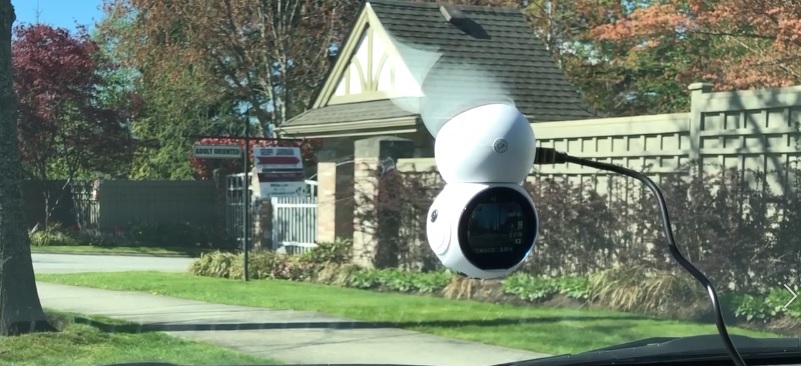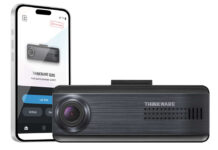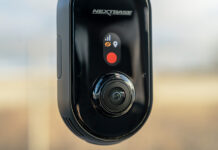 My wife and I have been in the market for dashcams for quite some time, and getting to review the JS Dashcam S and the JS Dashcam 2.0 was a neat treat. Both cameras are touted as “Plug and Play” cameras. You have two alternatives for hooking these cameras up. Either you can use the DC power adapter (I guess that’s what they call the “cigarette lighter” option now, since most cars don’t come with lighters and ashtrays standard anymore) or you can plug it into your vehicle’s USB input. Either one is fine.
My wife and I have been in the market for dashcams for quite some time, and getting to review the JS Dashcam S and the JS Dashcam 2.0 was a neat treat. Both cameras are touted as “Plug and Play” cameras. You have two alternatives for hooking these cameras up. Either you can use the DC power adapter (I guess that’s what they call the “cigarette lighter” option now, since most cars don’t come with lighters and ashtrays standard anymore) or you can plug it into your vehicle’s USB input. Either one is fine.
For the purpose of this review, I stuck the JS Dashcam 2.0 in our passenger sedan and the JS Dashcam S in our SUV. Both dashcams have fairly similar specs (separated mainly by little features), and both use the same app with basic app functions, so I figured it would just be the bells and whistles that set the two apart. I was wrong, as you’ll find out.
Both cameras connect to your smartphone (via a localized Wi-Fi connection) and can perform in temperatures as low as -30C and as high as 80C degrees Celsius. To access live and saved recordings from your smartphone, you’ll also need to download an app called “Novacam.” Oddly, the instructions didn’t seem to make reference to this app at all, but the name is written on the side of both boxes, and JS’ website refers to it as well.

A Look at the JS Dashcam 2.0: The More Comprehensive Option
This camera has a 170-degree WDR angle lens and says that it provides a 360-degree overall view. This is somewhat true in the sense that the camera is on a magnetic swivel, so you can very easily turn the camera to any angle at any point. I didn’t really take advantage of this very much outside of a quick left or right change, but you can point the camera back into the car if you feel like filming carpool karaoke instead of the dangerous drivers of your city. The default settings have full audio too, so Kate, DJ, and the rest of the blog team at Best Buy Head Office can take their Céline Dion show on the road!
In terms of local storage, you’re going to have to buy a Class 10 MicroSD card to store all the videos locally. Class 10 MicroSD storage is really cheap nowadays, and it shouldn’t break the bank. In fact, you can probably pick up a 16GB MicroSD card for about $10 if you want a small option until you decide how much you really need. The camera itself can support up to 128GB. The question really becomes how much storage you need.
The default settings on the camera are to record in its native 1080p with full audio. With this in mind, recording is around 81-82 MB per minute. This means that a 16 GB MicroSD card (which you should probably format before you use) will store about 3 hours of continuous loop recording. Thankfully, there’s no odd proprietary video encoding with this camera. It records in mp4 format for ease of use.

Before you stick your cam on your dash, you should run through menu settings to figure out how you want your recordings to generate, especially by quality and loop. I can’t really understand why you’d want to undercut the video quality itself, but loop recording is a really important feature.
The camera is set by default to a 1-minute loop, meaning that your videos are recorded in 1-minute segments. I felt that this really made for a headache when I started looking through video footage in the app the first couple of times I went through it.
Thankfully, the menu settings allow you to choose from 3, 5, or 10-minute continuous loop recording features. If you exceed your card’s memory, it will automatically overwrite the oldest footage.

This camera has a couple of really cool little features. The first is a parking sensor where if somebody hits your vehicle (or there is any sort of impact), the camera powers on to capture the incident. This is where that swivel mount might help, especially if you’re parked up against a wall and want to capture action behind you.
The second is something called a “G-Sensor.” G-Sensor is built into the camera and starts recording the moment it senses your car is hit. It’s pretty sensitive too. If you shake or jostle the car yourself on purpose, you can activate the G-Sensor option quite easily.
Lastly, if you need your dashcam to take still photos, it can do that too. While the still camera has a 4x zoom, it is ultimately restricted by either the length of the USB cable or the battery backup lifespan.
In my review video, I’ll show you the video recordings from this camera for both night and day (and with sound both on and off). The video and sound quality are both pretty good. You’re not going to get much exciting audio from my videos. I had to turn the music off while I was driving around capturing these small parts of the review so that the video wasn’t flagged for any copyright violations.

The camera, in general, is as advertised. It’s very plug and play, and even if you choose not to use the Novacam App with it regularly, it still picks up the last saved options when you start your car again. Just keep in mind that you should really be paying attention to what you do within the Novacam App because you can turn the recording on and off through it.
If you shut recording off in the app, the camera will not start recording again until you tell it to, even if you’ve shut your vehicle off and turned it on again.
While you can plug a micro USB cable into the camera itself, I noticed that it does tend to be a bit finicky if you choose to run it that way, and I’d only recommend doing this if you’re pulling the camera off to change the menu settings. Otherwise, leave the USB cable plugged into the base and control what you can from the app. I’ll speak more to the app at the bottom of the review.

A Look at the JS Dashcam S: A Great Entry Level Option

The JS Dashcam S has some of the same basic features as the JS Dashcam 2.0, but isn’t as feature-rich. While they basically operate and function the same way, the Dashcam S has a different mount, smaller onboard LCD screen, and some different default settings.
The Dashcam S also has a very small backup battery onboard (for when it’s taken off power) and can be hooked up directly to the adapter. It is also a plug and play camera, but the instructions warn that it should be charged for 10-15 minutes prior to full usage.
I admit, I like the mount on the Dashcam S more than the 2.0. The JS Dashcam S has a thin mount that allows you to angle it up and down a bit. The camera itself sits on a magnetic swivel base so that you can capture a 360 angle, and it too has the same audio and video recording settings.
By default, the Dashcam S is also set to 3 minute interval loops, but it can only max out in 5 minute loops (as opposed to the Dashcam 2.0’s 10).
I will say that I felt that the audio and video (and still photo) quality is equal since they have similar cameras and lenses, and presumably similar microphones.
Price point-wise, the S is a bit cheaper than the 2.0, and on this model, the manufacturer’s recommendation is a minimum 16 GB Class 10 MicroSD. The recording memory specs are about the same on this one as on the 2.0, so expect the 1080p recording to take about 81 MB per minute here too (and it is once again in mp4 format).
The same caveats with the Dashcam 2.0 apply to the S as well. Make sure you have the camera plugged into a power source before you start tinkering with menu settings (as the unit will just shut down if you pull it off the mount and start playing with the menu).

In the video review for this dashcam, you’ll see day and night footage, but with a bit of a twist. The footage I’m going to show you (taken with this camera) is in the rain so that you can see how JS Cameras record in both clear and rainy weather. The Night Vision cameras aren’t as strong on the S either, which you’ll see.
Just like the JS Dashcam 2.0, the Dashcam S comes equipped with their G-Sensor technology too, so that helpful feature is available with either choice you make. It does not have the parking sensor that the 2.0 model has, but the collision detection creates a recording file that cannot be overwritten (so that you have the footage handy for whomever needs it, without worry of deletion).

Are There Any Drawbacks to Either of These Dashcams?
With the plug and play mentality of both of these dashcams, the high-quality video and sound recordings, and the relative ease with which you can move them around, are there any drawbacks?
Honestly, the only area of development in my mind is the Novacam App itself. I should mention here that I was working with the iOS app, and it’s possible that the Android app looks more like the screenshots on the JS Innovations website, because the iOS app looks nothing like it. I felt that the app was fairly primitive and not as descriptive as I’d like it to be.
Everything you could possibly want (video exporting, downloading, etc) is there, but the main interface is driven by icons. It’s simple enough to figure out in the end, but I always think about my parents in scenarios like this. Following the easy time I’d have showing mom and dad how to install and get the camera running, I’d have a really hard time explaining the app to them.
I also found that on the JS Dashcam 2.0, the app’s connectivity with the camera itself was a tad spotty, and I had to unpair and pair the phone and camera a few times. Maybe it was just the review unit I had, since I didn’t have this problem at all with the Dashcam S.
Both units do run equally hot while in operation, but this is fairly normal. I found that the Dashcam S and the base actually ran much warmer than the Dashcam 2.0, but it doesn’t affect performance at all.
If you can make it past the really basic app and the fact that it needs some work (in my opinion) to properly compliment these user-friendly cameras, both of these JS Dashcams do the trick, and I recommend them if you’re looking for a plug and play option. If it’s within your budget to spend a few more bucks, however, I’d comfortably say that the JS Dashcam 2.0 is the one you want to go with. The parking sensor and better night vision, in my opinion, makes the extra cost well worth it.
Both the JS Dashcam 2.0 and the JS Dashcam S are now available online in the Best Buy Marketplace.




Have the Dash 2.0. works great. always wondered the difference between the 2.0 and the S. Thanks for the write up.
Fantastic review, always wanted one of these. If BestBuy Marketplace would like to send me one as a gift I would gladly accept it.
Comments are closed.